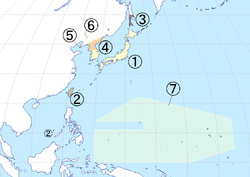Us occupation of japan
|
|||||
| Military occupation | |||||
|
|||||
|
Map of Japan under Allied occupation
|
|||||
| Capital | Tokyo | ||||
| Languages | Japanese | ||||
| Political structure | Military occupation | ||||
| Military Governor | |||||
| • | 1945–1951 | Douglas MacArthur | |||
| • | 1951–1952 | Matthew Ridgway | |||
| Emperor | |||||
| • | 1945–1952 | 124th Hirohito | |||
| Historical era | Cold War | ||||
| • | Japanese surrender | August 14, 1945 | |||
| • | Occupation established | August 28, 1945 | |||
| • | Instrument of Surrender signed | September 2, 1945 | |||
| • | Treaty of San Francisco |
April 28, 1952 | |||
| Today part of | |||||
The Allied occupation of Japan at the end of World War II was led by General Douglas MacArthur, the Supreme Commander of the Allied Powers, with support from the British Commonwealth. Unlike in the occupation of Germany, the Soviet Union was allowed little to no influence over Japan. This foreign presence marked the only time in Japan's history that it had been occupied by a foreign power. The country became a parliamentary democracy that recalled "New Deal" priorities of the 1930s by Roosevelt. The occupation, codenamed Operation Blacklist, was ended by the San Francisco Peace Treaty, signed on September 8, 1951, and effective from April 28, 1952, after which Japan's sovereignty – with the exception, until 1972, of the Ryukyu Islands – was fully restored.
According to John Dower, in his book Cultures of War: Pearl Harbor/Hiroshima/9-11/Iraq, the factors behind the success of the occupation were:
Discipline, moral legitimacy, well-defined and well-articulated objectives, a clear chain of command, tolerance and flexibility in policy formulation and implementation, confidence in the ability of the state to act constructively, the ability to operate abroad free of partisan politics back home, and the existence of a stable, resilient, sophisticated civil society on the receiving end of occupation policies – these political and civic virtues helped make it possible to move decisively during the brief window of a few years when defeated Japan itself was in flux and most receptive to radical change.
...
Wikipedia




